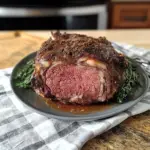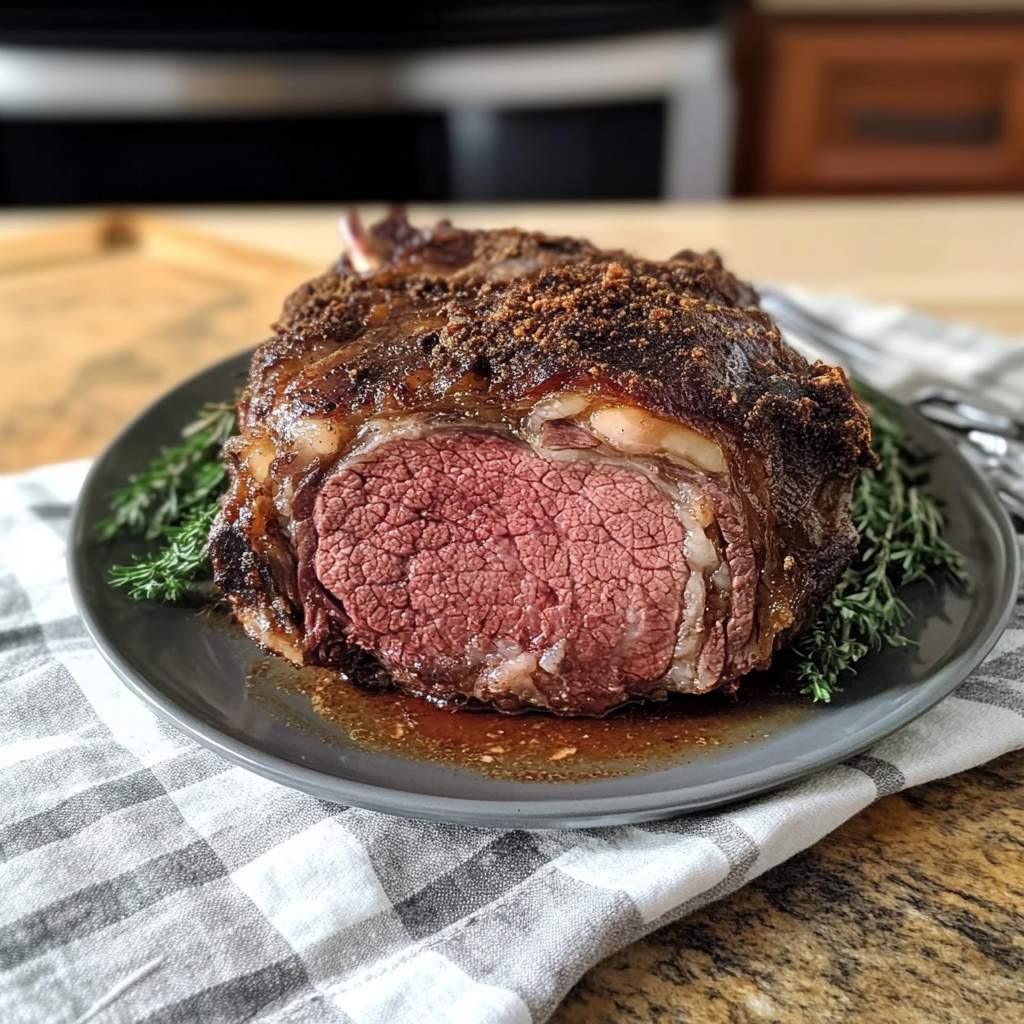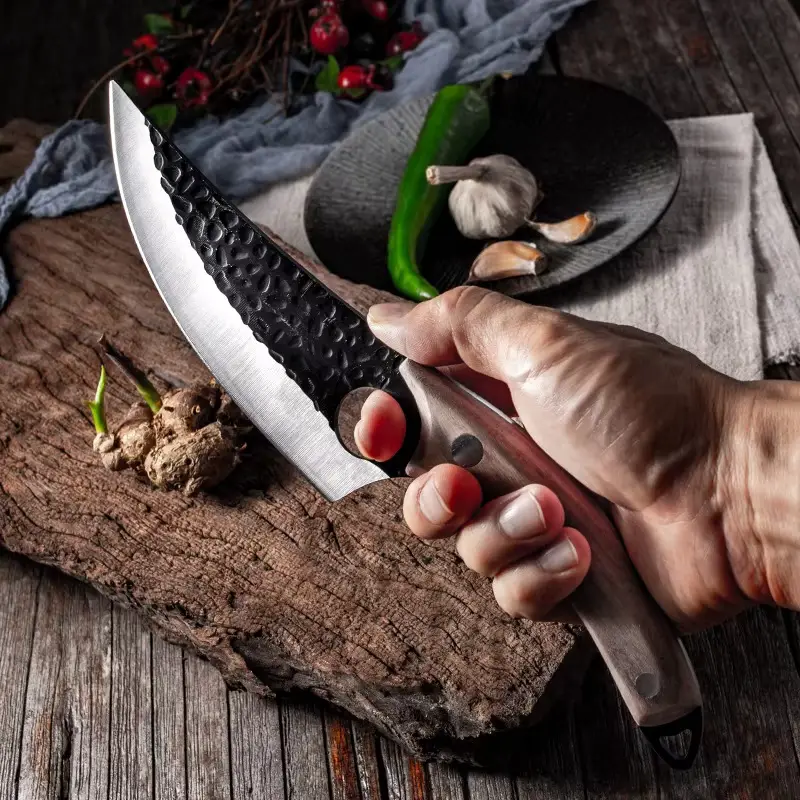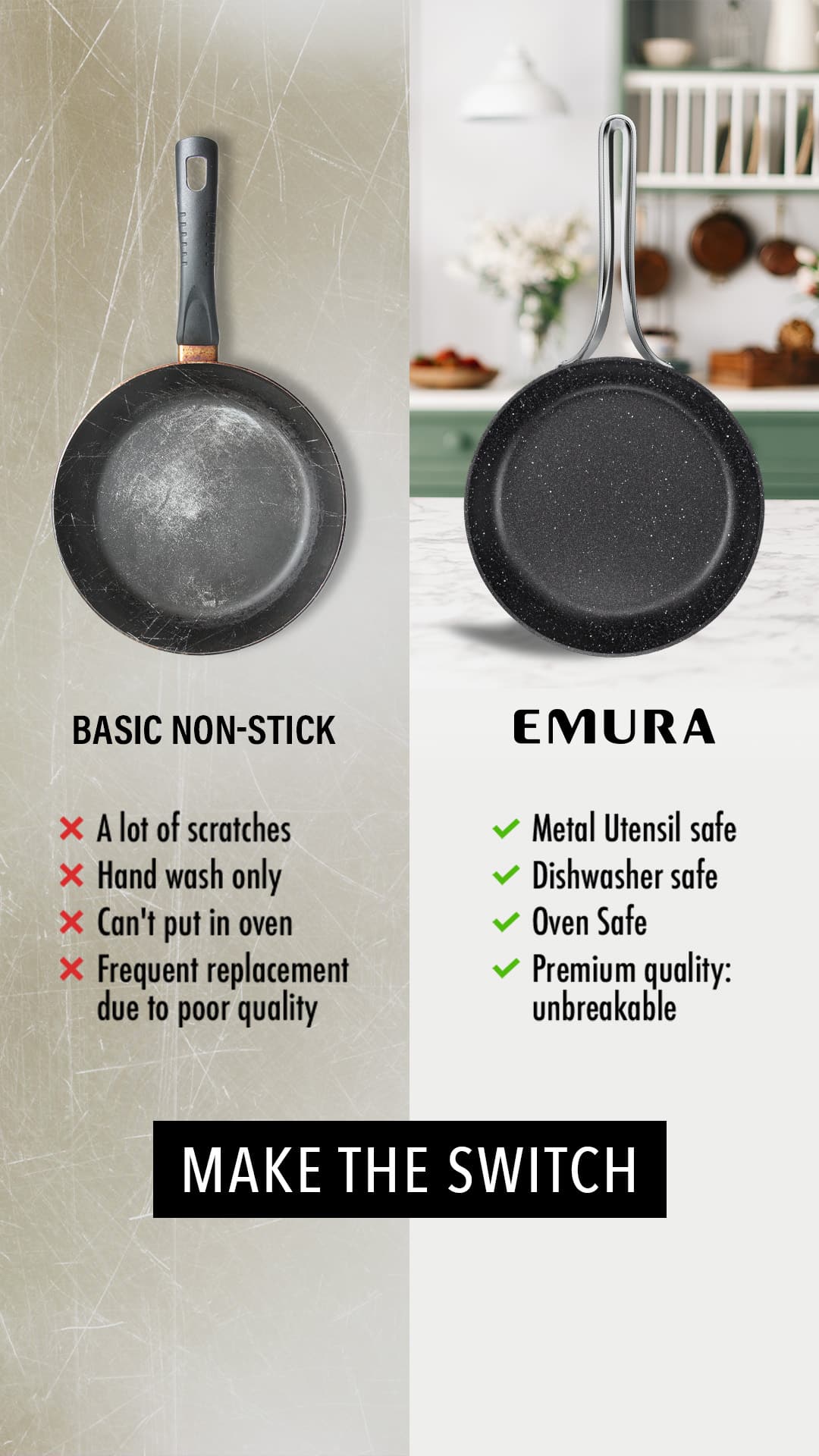When it comes to holiday feasts or special gatherings, few dishes make an impression quite like a perfectly cooked Boneless Prime Rib. Known for its incredible tenderness and rich, beefy flavor, prime rib is a cut that’s both decadent and surprisingly easy to prepare. This recipe will walk you through the steps to create a juicy, flavorful roast with a perfectly crusted exterior and a tender, pink center. Whether you’re an experienced cook or a beginner in the kitchen, this guide will ensure your prime rib turns out beautifully every time.
The key to a successful prime rib lies in a few essential techniques: seasoning the roast generously, allowing it to come to room temperature, using a high-heat sear, and then slow-roasting to finish. This combination of methods creates a crusty, flavorful outer layer while preserving the tender, juicy interior. In addition, this recipe includes tips on choosing the right cut, achieving the ideal level of doneness, and serving suggestions to make the most of this showstopping main course.
In this guide, I’ll cover everything you need to know, from choosing the best prime rib cut to perfectly seasoning, roasting, and resting it before serving. With these step-by-step instructions, you’ll be able to prepare a boneless prime rib that’s perfectly cooked and bursting with flavor, making it an unforgettable meal for family and friends.
Why You’ll Love This Recipe
Perfect for Special Occasions: Prime rib is the ultimate holiday or celebration dish, delivering an impressive presentation and incredible flavor.
Simple Preparation: Despite its elegant appearance, this recipe is easy to prepare with minimal ingredients and clear, straightforward steps.
Tender and Juicy: The low and slow roasting method ensures the prime rib stays tender, while a high-temperature sear creates a beautiful crust.
Customizable: You can adjust the seasonings and herbs to suit your taste, making this recipe adaptable for a variety of flavor profiles.
Crowd-Pleaser: A prime rib roast serves a crowd, making it ideal for gatherings and holiday meals where you want to impress your guests.
Preparation Time and Servings
- Prep time: 15 minutes (plus 2 hours to bring the roast to room temperature)
- Cook time: 2-2.5 hours (depending on the size and preferred doneness)
- Total time: 2.5-3 hours
- Yield: Serves 6-8
- Serving Size: 1-2 slices
Nutritional Information (per serving)
- Calories: 550 kcal
- Carbohydrates: 1g
- Protein: 50g
- Fat: 38g
- Fiber: 0g
- Sugar: 0g
Ingredients
For the Prime Rib:
- 1 boneless prime rib roast (5-7 lbs)
- 2 tablespoons olive oil
- 1 tablespoon kosher salt
- 1 tablespoon freshly ground black pepper
- 2 teaspoons garlic powder
- 2 teaspoons dried rosemary
- 2 teaspoons dried thyme
For the Herb Butter (Optional):
- 1/4 cup unsalted butter, softened
- 1 teaspoon minced garlic
- 1/2 teaspoon rosemary, chopped (or 1/4 teaspoon dried)
- 1/2 teaspoon thyme, chopped (or 1/4 teaspoon dried)
- 1/4 teaspoon black pepper
Step-by-Step Instructions
Step 1: Prepare the Prime Rib
- Season the Prime Rib: Place the prime rib on a baking sheet or large plate. Rub the olive oil over the entire surface of the roast. In a small bowl, combine the kosher salt, black pepper, garlic powder, dried rosemary, and dried thyme. Generously season the prime rib with the spice mixture, pressing it onto the meat to help it adhere. For the best flavor, allow the prime rib to sit at room temperature for 2 hours after seasoning. This helps the roast cook evenly and enhances flavor.
- Prepare the Herb Butter (Optional): For extra flavor, you can make an herb butter to spread over the roast before searing. In a small bowl, mix together the softened butter, minced garlic, chopped rosemary, chopped thyme, and black pepper. Set aside, but do not apply until after the initial sear.
Step 2: Sear the Prime Rib
- Preheat the Oven: Preheat your oven to 450°F (232°C) and position the oven rack in the center of the oven.
- Sear the Roast: Place the seasoned prime rib on a rack in a roasting pan. Insert the pan into the oven and roast at 450°F for 20 minutes. This high-temperature sear locks in the juices and creates a flavorful crust on the outside of the meat. After 20 minutes, remove the roast from the oven briefly. If you’re using the herb butter, carefully spread it over the top and sides of the prime rib at this point.
Step 3: Lower the Temperature and Roast Slowly
- Adjust the Oven Temperature: Reduce the oven temperature to 325°F (163°C). Return the prime rib to the oven and continue roasting until the internal temperature reaches your desired level of doneness. Use an instant-read meat thermometer to check the internal temperature. Generally, aim for 115°F for rare, 125°F for medium-rare, and 135°F for medium. The roast will continue to cook slightly as it rests, so remove it about 5-10 degrees below your target temperature.
- Check for Doneness: For a 5-7 lb roast, expect to cook for approximately 1.5-2 hours at 325°F. Check the temperature after the first hour, then every 15 minutes thereafter to ensure it doesn’t overcook. The key to a tender prime rib is to cook it low and slow, avoiding high heat that can make the meat tough.
- Rest the Roast: Once the prime rib reaches your desired temperature, remove it from the oven and cover it loosely with foil. Let it rest for 15-20 minutes before slicing. Resting allows the juices to redistribute throughout the meat, making it tender and juicy.
Step 4: Carve and Serve
- Slice the Prime Rib: Use a sharp carving knife to slice the prime rib into thick slices. For the most tender slices, cut against the grain. Place the slices on a serving platter, spooning any pan juices over the meat for added flavor.
- Serve with Accompaniments: Serve the prime rib alongside classic accompaniments like creamy horseradish sauce, au jus, or a red wine reduction. Garnish with fresh rosemary sprigs or thyme for an elegant presentation.
How to Serve Boneless Prime Rib
Prime rib is a versatile main course that pairs well with various sides and sauces. Here are a few ideas to round out your meal:
- With Horseradish Sauce: The sharpness of horseradish complements the richness of prime rib, adding a flavorful contrast.
- With Au Jus or Red Wine Sauce: Drizzle a little au jus or a rich red wine reduction over the meat for extra flavor and moisture.
- With Classic Sides: Serve with roasted garlic mashed potatoes, green beans, roasted carrots, or creamed spinach for a traditional feast.
- With Yorkshire Pudding: Yorkshire pudding is a classic pairing with prime rib, offering a delicious, fluffy side that soaks up the pan drippings.
Additional Tips for Success
- Choose a High-Quality Prime Rib: Look for USDA Prime or Choice grade prime rib for the best flavor and marbling. The fat within the roast will keep it moist and tender.
- Let the Prime Rib Come to Room Temperature: Allowing the roast to sit at room temperature before cooking helps it cook more evenly, resulting in a tender and juicy roast.
- Use an Instant-Read Thermometer: A meat thermometer is essential for achieving the perfect doneness. Insert it into the thickest part of the meat for an accurate reading.
- Resting is Key: Don’t skip the resting period after cooking. This step allows the juices to settle, making each slice juicier and more flavorful.
- Save the Drippings: The pan drippings are full of flavor and can be used to make an au jus or gravy to serve alongside the prime rib.
Recipe Variations
- Garlic Herb-Crusted Prime Rib: Add a mixture of fresh rosemary, thyme, minced garlic, and olive oil to create a garlic-herb crust that adds even more flavor.
- Smoked Prime Rib: If you have a smoker, cook the prime rib at a low temperature with wood chips for a smoky flavor. The result is a beautifully smoked prime rib with a deep, savory flavor.
- Peppercorn-Crusted Prime Rib: Roll the prime rib in cracked black pepper before roasting for a peppery, flavorful crust.
- Prime Rib with Red Wine Reduction: Serve the roast with a rich red wine reduction for a sophisticated touch. Simply reduce red wine with shallots, garlic, and beef stock to make the sauce.
- Horseradish Crusted Prime Rib: Spread a thin layer of prepared horseradish over the roast before baking for a unique and flavorful twist.
Freezing and Storage
- Storing Leftovers: Place any leftover prime rib slices in an airtight container and refrigerate for up to 3 days. Reheat gently in a skillet or in the oven to maintain the meat’s tenderness.
- Freezing: Prime rib freezes well. Wrap each slice individually in plastic wrap, then place in a freezer-safe bag. Store in the freezer for up to 2 months.
- Reheating: For best results, reheat in the oven at a low temperature to prevent overcooking. Wrap the slices in foil and warm at 250°F until heated through.
Special Equipment
- Roasting Pan with Rack: A roasting pan with a rack is ideal for cooking prime rib, allowing for even heat circulation and keeping the meat elevated from the juices.
- Meat Thermometer: A digital or instant-read thermometer ensures you reach your desired level of doneness without overcooking.
- Sharp Carving Knife: A sharp knife is essential for slicing the prime rib cleanly and evenly.
Frequently Asked Questions
1. Can I cook prime rib without a rack?
Yes, you can place the roast directly in the pan or use vegetables like carrots and celery to elevate it from the pan, allowing airflow and even cooking.
2. Can I use bone-in prime rib for this recipe?
Absolutely. Bone-in prime rib adds extra flavor and can be cooked similarly, but may take a bit longer depending on the thickness of the bones.
3. How do I prevent the prime rib from drying out?
Use a meat thermometer to avoid overcooking and remove the roast from the oven 5-10 degrees below your desired temperature. Also, let the roast rest before slicing.
4. What’s the best way to reheat prime rib?
Reheat in a low-temperature oven wrapped in foil to preserve tenderness. Avoid microwaving, as it can make the meat tough.
5. Can I prepare the roast ahead of time?
Yes, season the roast a day in advance and let it sit, uncovered, in the fridge to allow the seasonings to penetrate the meat.
Conclusion
This Boneless Prime Rib Recipe is an absolute showstopper, delivering a juicy, tender roast with a beautifully crusted exterior. The combination of simple seasonings, slow roasting, and high-heat searing creates a dish that’s both impressive and delicious, perfect for holiday gatherings, special occasions, or when you want to treat your family and friends to an unforgettable meal. With a few key techniques and a little patience, you’ll have a perfectly cooked prime rib that’s bursting with flavor and incredibly satisfying. Pair it with classic sides and sauces, and enjoy every bite of this luxurious main course. Whether you’re a seasoned cook or new to roasting, this recipe is sure to be a hit at your table. Enjoy the process, and happy cooking!
Print
Boneless Prime Rib Recipe
- Total Time: 3 hours
- Yield: Serves 6-8 1x
Ingredients
For the Prime Rib:
- 1 boneless prime rib roast (5–7 lbs)
- 2 tablespoons olive oil
- 1 tablespoon kosher salt
- 1 tablespoon freshly ground black pepper
- 2 teaspoons garlic powder
- 2 teaspoons dried rosemary
- 2 teaspoons dried thyme
For the Herb Butter (Optional):
- 1/4 cup unsalted butter, softened
- 1 teaspoon minced garlic
- 1/2 teaspoon rosemary, chopped (or 1/4 teaspoon dried)
- 1/2 teaspoon thyme, chopped (or 1/4 teaspoon dried)
- 1/4 teaspoon black pepper
Instructions
Step 1: Prepare the Prime Rib
- Season the Prime Rib: Place the prime rib on a baking sheet or large plate. Rub the olive oil over the entire surface of the roast. In a small bowl, combine the kosher salt, black pepper, garlic powder, dried rosemary, and dried thyme. Generously season the prime rib with the spice mixture, pressing it onto the meat to help it adhere. For the best flavor, allow the prime rib to sit at room temperature for 2 hours after seasoning. This helps the roast cook evenly and enhances flavor.
- Prepare the Herb Butter (Optional): For extra flavor, you can make an herb butter to spread over the roast before searing. In a small bowl, mix together the softened butter, minced garlic, chopped rosemary, chopped thyme, and black pepper. Set aside, but do not apply until after the initial sear.
Step 2: Sear the Prime Rib
- Preheat the Oven: Preheat your oven to 450°F (232°C) and position the oven rack in the center of the oven.
- Sear the Roast: Place the seasoned prime rib on a rack in a roasting pan. Insert the pan into the oven and roast at 450°F for 20 minutes. This high-temperature sear locks in the juices and creates a flavorful crust on the outside of the meat. After 20 minutes, remove the roast from the oven briefly. If you’re using the herb butter, carefully spread it over the top and sides of the prime rib at this point.
Step 3: Lower the Temperature and Roast Slowly
- Adjust the Oven Temperature: Reduce the oven temperature to 325°F (163°C). Return the prime rib to the oven and continue roasting until the internal temperature reaches your desired level of doneness. Use an instant-read meat thermometer to check the internal temperature. Generally, aim for 115°F for rare, 125°F for medium-rare, and 135°F for medium. The roast will continue to cook slightly as it rests, so remove it about 5-10 degrees below your target temperature.
- Check for Doneness: For a 5-7 lb roast, expect to cook for approximately 1.5-2 hours at 325°F. Check the temperature after the first hour, then every 15 minutes thereafter to ensure it doesn’t overcook. The key to a tender prime rib is to cook it low and slow, avoiding high heat that can make the meat tough.
- Rest the Roast: Once the prime rib reaches your desired temperature, remove it from the oven and cover it loosely with foil. Let it rest for 15-20 minutes before slicing. Resting allows the juices to redistribute throughout the meat, making it tender and juicy.
Step 4: Carve and Serve
- Slice the Prime Rib: Use a sharp carving knife to slice the prime rib into thick slices. For the most tender slices, cut against the grain. Place the slices on a serving platter, spooning any pan juices over the meat for added flavor.
- Serve with Accompaniments: Serve the prime rib alongside classic accompaniments like creamy horseradish sauce, au jus, or a red wine reduction. Garnish with fresh rosemary sprigs or thyme for an elegant presentation.
- Prep Time: 15 minutes (plus 2 hours to bring the roast to room temperature)
- Cook Time: 2-2.5 hours (depending on the size and preferred doneness)
Nutrition
- Serving Size: 1-2 slices
- Calories: 550 kcal
- Sugar: 0g
- Fat: 38g
- Carbohydrates: 1g
- Fiber: 0g
- Protein: 50g



